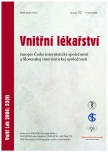Monitoring of glucose concentration in critical patients, comparing arterial blood glucose concentrations and interstitial glucose concentration measured by microdialysis technique
Authors:
J. Křemen 1; J. Bláha 2; M. Matias 2; K. Anderlová 1; M. Ellmerer 3; J. Plank 3; T. Pieber 3; Š. Svačina 1; M. Haluzík 1
Authors‘ workplace:
III. interní klinika 1. lékařské fakulty UK a VFN, Praha, přednosta prof. MUDr. Štěpán Svačina, DrSc., MBA
1; Klinika anesteziologie, resuscitace a intenzivní medicíny 1. lékařské fakulty UK a VFN, Praha, přednosta MUDr. Martin Stříteský, CSc.
2; Interní klinika Lékařské Univerzity, Graz, Rakousko, přednosta prof. MUDr. Ernst Pilger
3
Published in:
Vnitř Lék 2006; 52(9): 777-781
Category:
Original Contributions
Overview
Introduction:
Recent studies have shown that normalization of blood glucose in critically ill patients by intensive insulin therapy significantly decreases their mortality and morbidity. The aim of our study was to compare interstitial glucose concentrations in subcutaneous adipose tissue (measured by microdialysis technique) and arterial blood glucose concentrations to test the suitability of subcutaneous adipose tissue for long-term placement of biosensors for glucose measurement in critically ill patients.
Patients and methods:
20 patients (16 men and 4 women) after cardiac surgery hospitalized at postoperative intensive care unit were included into the study. Mean age was 68 ± 10 years, BMI was 28.3 ± 3.9 year. Only patients with glycemia higher than 6.7 mmol/l at a time of admission to the ICU were included. Samples for measurement of interstitial glucose concentrations were collected in 60 minutes intervals during 48 hours using microdialysis of the subcutaneous adipose tissue. Perfusion fluid was 5% mannitol, perfusion rate was 1 µl/min. Arterial blood glucose concentration was measured in 60 minutes intervals, absolute concentrations of interstitial glucose were calculated using ionic reference technique.
Results:
Mean arterial glucose concentration during the study was 6.7 ± 0.56 mmol/l, absolute concentration of glucose in interstitial fluid was 3.55 ± 0.58 mmol/l. Mean correlation coefficient between arterial and interstitial concentrations was 0.77 ± 0.15.
Conclusion:
Our study demonstrated good correlation between interstitial glucose concentrations in subcutaneous adipose tissue and arterial blood glucose concentrations in post-cardiac surgery patients. Further studies are needed to evaluate this relationship in patients with more severely disturbed perfusion of subcutaneous adipose tissue.
Keywords:
microdialysis - glycemia - interstitial fluid - critical illness
Sources
1. Van den Berghe G, Wouters P, Weekers F et al. Intensive insulin therapy in the critically ill patients. N Engl J Med 2001; 345: 1359–1367.
2. Pittas AG, Siegel RD, Lau J. Insulin therapy for critically ill hospitalized patients: a meta-analysis of randomized controlled trials. Arch Intern Med 2004; 164: 2005–2011.
3. Furnary AP, Wu Y, Bookin SO. Effect of hyperglycemia and continuous intravenous insulin infusions on outcomes of cardiac surgical procedures: the Portland Diabetic Project. Endocr Pract 2004; 10: Suppl 2: 21–33.
4. Van den Berghe G. How does blood glucose control with insulin save lives intensive care? J Clin Invest 2004; 114: 1187–1195.
5. McCowen KC, Malhotra A, Bistrian BR. Stress-induced hyperglycemia. Crit Care Clin 2001; 17: 107–124.
6. Grimble RF. Inflammatory status and insulin resistance. Curr Opin Clin Nutr Metab Care 2002; 5: 551–559.
7. Aulak KS, Koeck T, Crabb JW et al. Dynamics of protein nitration in cells and mitochondria. Am J Physiol Heart Circ Physiol 2004; 286: H30–H38.
8. Ellmerer M, Haluzik M, Blaha J et al. Clinical Evaluation of Alternative Site Glucose Measurements in Patients after Major Cardiac Surgery. Diabetes Care 2006; 29: 1275–1281.
9. Plank J, Blaha J, Cordingley J et al. Multicentric, randomized, controlled trial to evaluate blood glucose control by the model predictive control algorithm versus routine glucose management protocols in intensive care unit patients. Diabetes Care 2006; 29: 271–276.
10. Štich V. Mikrodialýza – nová metoda sledování metabolismu tukové tkáně. DMEV 1998; 1: 90–93.
11. Eliasson A. Microdialysis – principles of recovery, 1991 CMA, Sweden, www. microdialysis.se
12. Trajanoski Z, Brunner GA, Schaupp L et al. Open-flow microperfusion of subcutaneous adipose tissue for on-line continuous ex vivo measurement of glucose concentration. Diabetes Care 1997; 20: 1114–1121.
13. Arner P. Use of microdialysis to study metabolism in humans. Microdialysis Academy 1997; 3.
14. Röjdmark J. Microdialysis in plastic surgery. Microline 1997; vol. 3. www.microdialysis. se.
15. Nordström C. Implementation of intracerebral microdialysis in neurointensive care. Microline 1997; 3. www.microdialysis. se.
16. Schaupp L, Ellmerer M, Brunner GA et al. Direct access to interstitial fluid in adipose tissue in humans by use of openflow microperfusion. Am J Physiol 1999; 276: E401–E408.
17. Pfeiffer EF, Meyerhoff C, Bischof F et al. On line continuous monitoring of subcutaneous tissue glucose is feasible by combining portable glucosensor with microdialysis. Horm Metab Res 1993; 25: 121–124.
18. Ungerstedt U, Rostami E. Microdialysis in neurointensive care. Curr Pharm Des 2004; 10: 2145–2152.
Labels
Diabetology Endocrinology Internal medicineArticle was published in
Internal Medicine

2006 Issue 9
Most read in this issue
- MELD score in prediction of early mortality in patients suffering refractory ascites treated by TIPS
- Chronic autoimmune thyroiditis and connective tissue system diseases
- Diuretics in therapy of „diuretic resistance“ by patients with congestive heart failure
- Tumor angiogenesis
